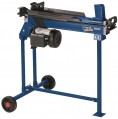Splitting force
The greatest force that the wood splitter is able to apply to the workpiece in the process of splitting.
This parameter is relevant for hydraulic and rack units (see "Type"). Even in the simplest such devices, the splitting force reaches several tons. In general, high force allows you to cope with hard and thick workpieces, however, it requires high power and strength, which significantly affects the price and weight of the entire unit. Therefore, it is worth choosing a model according to this characteristic, taking into account the specifics of the work.
So, for use in the private sector, a wood splitter with a splitting force of up
to 5 tons is considered quite sufficient, for boiler rooms and other relatively large consumers —
5-8 tons (up to 10 tons), and
more powerful devices are intended mainly for industrial use.
Max. log length
The longest log that a log splitter can handle. In fact, this is the largest distance that the stop and working nozzle can be spread; if the workpiece is longer than this distance, it will have to be sawn.
Note that this indicator significantly affects the dimensions (especially in a horizontal working position), and the force required to split a long log is quite high. Therefore, for small volumes of work (for example, when harvesting firewood for a private house), a wood splitter with a relatively small maximum length is often the best choice —
up to 60 cm ; longer workpieces can be sawn. But models of
more than 60 cm are intended mainly for work on a large scale.
Oil volume (hydraulic system)
The total amount of oil that can fit into the hydraulic system of the respective log splitter (see "Type"). This parameter allows you to estimate how much oil is required for one refueling or refilling of the unit.
4-way splitter
The presence in the delivery set of the wood splitter of the
nozzle for splitting the workpiece into 4 parts. Such a nozzle usually has a set of blades in the form of a cross and, if necessary, is installed on the main working tool. "Cross" allows you to get log quarters in one pass (whereas without it it would take three — to split into halves and for each individual half). However for very thin or thick workpieces, such splitting is poorly suited — the centre of the log may not coincide with the centre of the nozzle.
Stand
The presence of high legs
(stands) for a horizontal wood splitter will allow you to use it when it is installed immediately on the ground, floor. There is no need to make an additional elevation in the form of a table, a workbench for more convenient feeding and chopping of small logs. But compact models of
horizontal wood splitters without a stand are of two types. The first includes ground models for chopping powerful logs, which it makes no sense to raise to a height. The second type provides wood splitters for installation on a hill, which, due to the lack of a stand, must be provided in advance. In both cases, the absence of a stand (high legs) makes the model more compact and more mobile.
Country of origin
Country of origin of the brand under which the log splitter is presented on the market. This country does not necessarily coincide with the place of actual production — on the contrary, it is not uncommon for individual parts to be produced in one state, assembled in another, and the brand generally comes from a third.
Also note that the country of origin itself does not affect the quality of the goods — a lot depends on the specific brand and even specific models. So it makes sense to pay attention to this information mainly in those cases when you fundamentally want (or do not want) to support a manufacturer from a certain country. Among the countries producing wood splitters are:
Austria,
Belarus,
Germany,
Denmark,
China,
Poland,
Russia,
USA,
Slovenia,
Ukraine,
Czech Republic,
Japan.

